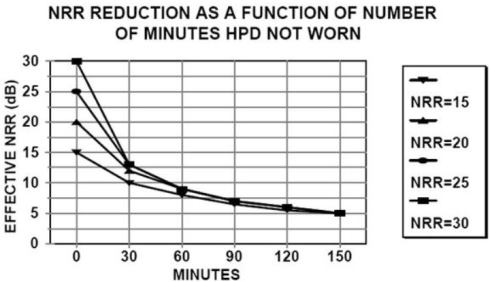
Selecting Hearing Protectors—It's the Fit That Counts
In addition to selecting HPDs and documenting the PAR achieved by each worker, hearing protector fit testing is a critical component to worker training.
- By Ted Madison
- Oct 01, 2016
From disposable to reusable, basic ear muffs and communication-enabled headphones with a built-in AM/FM radio, there is an enormous variety of Hearing Protection Devices (HPDs) on the market. Selecting the right HPD can seem daunting when considering all of the options available and the unique needs of each worker on site.
For every workplace and for each individual worker, circumstances vary due to noise exposures, working conditions, methods of communication, and individual preferences. Ear shapes and sizes also vary widely, so much so that scientists are discovering that ears could be one of the most accurate yet least intrusive ways to identify someone. With this in mind, hearing protection challenges cannot be met with a one-size-fits-all approach. But selecting the right hearing protection is easier than you think. The task of finding the right solution can be boiled down to finding equipment that achieves the right balance of comfort, noise reduction, ease of use, and fit.
"Fit" is truly the key. As it turns out, nearly any hearing protector worn correctly and for the entire time a person is exposed to loud noise will provide more effective protection than other devices that don't fit well, aren’t properly worn, or aren't worn as long as they should be. So, with all these different types of hearing protectors, how do employers find the right fit? This article will touch on the qualifications employers need to check off their list to make sure they’re selecting the right HPDs for their workforce.
HPD Selection Checklist
Comfort
A comfortable hearing protector that fits is more likely to be worn correctly and longer than an uncomfortable HPD. If hearing protectors aren't worn for the entire time a person is exposed to hazardous sounds, the effective protection for that person drops dramatically, as shown in the wear time chart. For example, wearing hearing protection seven hours in an eight-hour workday can cause the effectiveness of the HPD to drop by more than half (NIOSH, 1996).

Figure 1. From NIOSH publication 96-110, Preventing Occupational Hearing Loss—A Practical Guide
Comfort is also instrumental in getting the user to be willing to comply with the company's hearing conservation program and wear his or her HPD. Comfort is influenced by:
- Pressure. While a certain degree of pressure is necessary to block out noise, too much can cause pain. With a disposable foam ear plug, both the type of foam and size of the ear plug can create pressure inside the ear canal, causing discomfort if not fitted or inserted properly. With an ear muff, if the pressure from the ear cups or headband is excessive, the discomfort can be great enough to cause headaches and pain.
- Size. Finding the right size is critical. Even foam ear plugs, often provided in a one-size-fits-all dispenser, come in multiple sizes to fit appropriately in the ear canal. For ear muffs, the size of the ear cup is closely related to the amount of noise reduction they can provide.
- Weight. Lighter ear muffs with slightly lower noise reduction may allow the wearer to hear loud important sounds more easily and may feel more comfortable, allowing the wearer to leave them on for longer periods.
- Softness. Ear plugs come in different materials that feature varying levels of softness. Many people prefer softer ear plugs, especially workers who reinsert a new pair of ear plugs several times a day.
- Heat and humidity. In hot, humid environments, ear muffs may not be comfortable for more than a few minutes. Lightweight alternatives such as banded HPDs and washable, reusable ear plugs may be a more hygienic and comfortable option.
Ease of Use
While it's true that the most effective HPD is the one that workers wear, the device must be easy to use. Even the best hearing protectors won't be used if they aren't convenient and compatible with other personal protective equipment being worn, such as goggles, and the work being done.
Workers who need to put their hearing protection on in a hurry or who take off and put on hearing protection many times every day may benefit from "ready to wear" ear plugs, such as push-to-fit style ear plugs with soft foam tips mounted on flexible stems, helmet-mounted ear muffs, or corded ear plugs that allow workers to keep their ear plugs conveniently tethered to their safety glasses.
Attenuation – Controlling the Noise Level
Selecting hearing protectors with the right amount of attenuation is the key to success, not only for the sake of lowering the employee's noise exposure, but also to improve employee acceptance and maintain effective communication. In some cases, the right amount is determined by the need to hear conversation. In other cases, for example, when noise levels are very high and communication is not a factor, maximizing noise reduction is better.
Noise Reduction Rating (NRR)
The NRR, printed on each package, is an indicator of how well the hearing protector performs in a laboratory under ideal conditions, including correct fit for the wearer. However, the NRR turns out to be a very poor indicator of how well hearing protectors perform in the workplace. In order to use it correctly, OSHA requires employers to adjust the NRR to account for how noise is measured and the difference between HPD performance in the laboratory and on the job site (see the OSHA Noise & Hearing Conservation e-tool).
Perhaps a bigger challenge with using the NRR as a gauge of HPD performance is that it cannot be used to accurately estimate the noise reduction achieved by an individual worker and doesn’t take into account that noise reduction obtained with any given HPD worn on the job varies widely from one worker to another.
Fit testing—a best practice
Given the limitations of the NRR described above, more and more employers are incorporating hearing protector fit testing into their hearing conservation programs. The noise reduction provided by the hearing protector can be measured directly and objectively with a technology known as Field Microphone in Real Ear (F-MIRE) measurement. This technology allows employers to quickly measure how much hearing protection the employee is receiving. Since F-MIRE fit testing is objective, it takes only two to three seconds to measure the noise reduction at seven different frequencies in each ear without the need for the employee to listen or respond to the test signals. Once the measurement is completed, the software calculates and displays an overall performance rating for each employee, known as the Personal Attenuation Rating or PAR.
In addition to selecting HPDs and documenting the PAR achieved by each worker, hearing protector fit testing is a critical component to worker training. The few minutes spent with each worker individually leads to measureable improvement in ear plug fitting and higher PARs.
Communication
One of the biggest myths that can result in reluctance to wear hearing protection is that workers won’t be able to hear each other. It is true that HPD wearers won't hear as much as they did without hearing protection. That said, if the hearing protector selected has the appropriate amount of noise reduction for the exposure and if the HPD is worn according to user instructions, in most high-noise situations, most workers should still be able to hear each other to some extent while wearing hearing protection.
For situations where noise levels are only slightly elevated and overprotection and reduced communication ability are a concern, there are HPDs that provide moderate or lower attenuation. In high-volume areas, workers who communicate face to face, by radio, or by phone can use an HPD with electronic communication features. Ear plugs and ear muffs with Level Dependent microphones can boost the hearing level of the listener when the noise on the work site is low while automatically limiting loud sounds. Radio-connected headsets can improve the audibility of radio communication by using noise-cancelling microphones and noise-isolating cushions to block out unwanted noise.
The Bottom Line
The best, most effective personal safety equipment, whether it be goggles, a fall protection harness, or hearing protection, is the equipment workers wear. To make sure they wear it correctly and consistently, it has to be comfortable and fit well.
When considering hearing protection options, comfort and fit need to be balanced with the right amount of noise reduction and ability to communicate to be most effective. Thanks to new technologies that make it possible to test the fit and measure the noise reduction of each hearing protector and the increasing availability of devices that provide both noise reduction and communication capabilities, it is easier than ever to achieve that balance.
To help workers choose the right equipment for their job and hearing, it's best to enlist the help of a hearing safety specialist. With the right measurement tools and access to a variety of HPDs for workers to try and test, they can make selecting the right equipment even easier.
To learn more, please visit:
This article originally appeared in the October 2016 issue of Occupational Health & Safety.